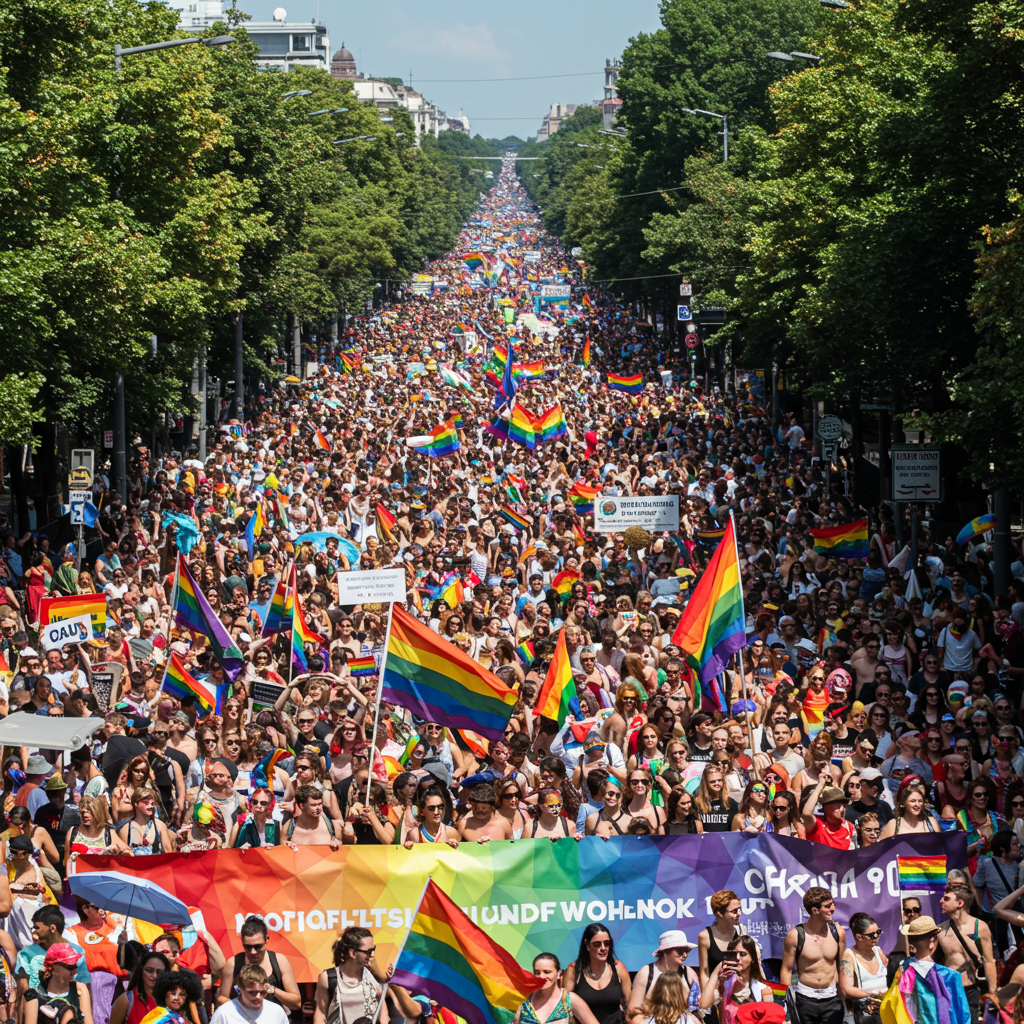budapest pride 2025 unfolded under a brilliant blue sky, not just as Hungary’s largest-ever lgbtq+ celebration, but as a powerful and unprecedented act of defiance against Prime Minister Viktor Orbán’s government. With an estimated 200,000 participants from 30 countries, the march on Saturday represented a massive increase from previous years, transforming a traditional event into a potent symbol of resistance against a decade-long crackdown on rights. This wasn’t just about Pride; for many, it was a protest against a broader rollback of democratic freedoms under Orbán’s national-conservative Fidesz party.
The sheer scale of the turnout, coupled with significant international backing, sent a clear message. It demonstrated that even in a country where the government has relentlessly sought to restrict LGBTQ+ visibility and rights, there remains a powerful will to stand up and be seen. The event became a critical flashpoint, highlighting the deep divide between the government’s pursuit of traditionalist policies and the aspirations of a significant portion of the population and the wider European community.
A Decade of Reversed Progress
Hungary was once seen as a beacon of progress in Central and Eastern Europe following the fall of communism. In 1997, Budapest hosted the region’s first Pride parade, and the country later legalized same-sex civil partnerships in 2007. However, the election of Viktor Orbán and Fidesz marked a dramatic shift. Positioning the party as champions of traditional Christian and family values, the government has systematically reversed earlier advancements.
Orbán’s approach aligns with a broader “culture war” strategy seen in other nationalist-conservative movements globally. This strategy often combines anti-immigration stances with measures aimed at promoting what is framed as a traditional demographic and cultural identity. By linking issues like LGBTQ+ rights and abortion to concerns about birthrates and national identity, the government taps into demographic anxieties. They seek to incentivize childbearing among the native population while simultaneously restricting rights for groups perceived as outside this traditional framework. This creates a narrative where defending traditional family structures and restricting LGBTQ+ visibility becomes intertwined with safeguarding the nation’s future.
Within a year of taking power, Orbán’s government, backed by a strong parliamentary majority, amended the constitution to ban same-sex marriage. Subsequent legislative changes prohibited same-sex adoption and specifically defined the family unit based on heterosexual marriage, stating explicitly: “The mother is a woman and the father is a man.”
Escalating Restrictions and the Attempted Ban
The crackdown intensified over the years. In 2021, Hungary passed controversial “child protection legislation.” This law effectively banned any “depiction or promotion” of homosexuality or gender change to minors. This had wide-ranging implications, impacting educational materials, films, advertisements, and television shows aimed at those under 18.
Building on this, earlier this year, parliament amended the country’s law on assembly. The new legislation made it an offense to organize or attend events, including Pride, that were deemed to violate the “child protection” measures. Crucially, this amendment also authorized the use of facial recognition software to identify and potentially fine attendees.
This latest restriction directly targeted Budapest Pride. Police confirmed that attending the march would be illegal under the new rules. They warned attendees could face fines ranging from €16 to €500, while organizers risked up to a year in prison. This attempt to legally ban the event sparked immediate and widespread outrage among Hungary’s LGBTQ+ community and rights advocates.
Resistance Finds a Loophole
Despite the government’s clear intent to stop the march, organizers, rights campaigners, and a chorus of international voices pushed back powerfully. Amnesty International condemned the proposed ban as a “full-frontal attack” on the LGBTQ+ community and a “blatant violation” of free speech and assembly rights. An international petition garnered over 120,000 signatures demanding that police allow the march to proceed peacefully.
Hadja Lahbib, the EU’s Commissioner for equality, emphasized that the right to peaceful assembly is a fundamental right across the EU. However, the Hungarian Justice Minister, Bence Tuzson, doubled down, warning 33 foreign embassies against attending the march, stating it was a “legally banned assembly.”
The turning point came from Budapest’s liberal mayor, Gergely Karácsony, a vocal critic of the national government. Mayor Karácsony identified a legal loophole: municipal events do not require official state authorization. By having the city hall organize the gathering, police powers to intervene were circumvented.
This ingenious tactic allowed the march to proceed. It also emboldened international support. Twenty EU governments signed a collective statement criticizing the ban attempt. More than 70 Members of the European Parliament pledged to attend. On the day, high-profile European figures including the Vice-President of the European Parliament, ministers from the Netherlands and Spain, and mayors from Brussels and Amsterdam, joined the march in a show of solidarity.
A Symbol of Broader Resistance
European community affairs correspondent Ashifa Kassam highlighted the significance of the event, stating that Budapest Pride 2025 became “a sort of red line.” She noted it symbolized a “rallying call for the resistance” against the wider erosion of rights and democratic norms occurring in Hungary. The event transcended a single issue, becoming a platform for expressing discontent with the government’s direction across various fronts.
The record turnout wasn’t solely composed of LGBTQ+ individuals and their allies. Many attendees participated specifically to protest the government’s broader policies and perceived crackdown on democratic freedoms. The scale of this unified opposition presented a significant embarrassment for Viktor Orbán and his administration, forcing them to confront visible dissent on a massive scale.
The political backdrop to this defiance is complex. Hungary’s relationship with the European Union remains strained, with the EU withholding access to €18 billion in funds due to concerns over the rule of law, including issues of corruption and treatment of asylum seekers. The EU Commission has initiated proceedings regarding the 2021 “child protection” law and is examining the recent assembly law, citing the EU treaty principles of human dignity, pluralism, non-discrimination, and tolerance.
EU Commission President Ursula von der Leyen eventually spoke out against the ban, prompting a characteristic retort from Orbán that she could not “dictate to Hungarians from Brussels how they should live.”
Domestic Political Calculations
Domestically, the event played out against a backdrop of shifting political dynamics. For months, Orbán has been trailing opposition leader Péter Magyar and his centre-right Tisza party in opinion polls ahead of elections scheduled for next April. Magyar has largely avoided taking a clear stance on LGBTQ+ issues, potentially to avoid alienating conservative voters critical to his strategy.
Some analysts suggest that Orbán might have intended the Pride ban to force Magyar into a difficult position, compelling him to address a contentious cultural issue and potentially allowing Fidesz to peel off conservative support, particularly in rural areas. However, Magyar has reportedly resisted this pressure, maintaining his strategic silence on the topic. This leaves Orbán navigating the fallout from an attempted ban that not only failed but galvanized his opposition.
What Lies Ahead?
The unprecedented scale of Budapest Pride 2025 and the visible presence of numerous European politicians will undoubtedly send ripples through both Hungarian and European politics. The EU Commission is already scrutinizing Hungary’s use of facial recognition technology at public events, a practice that digital and human rights groups argue violates the EU AI Act.
While the police did not physically intervene during the march itself – Orbán had stated Hungary was a “civilised country” where police would not “break up” the parade – he also promised “legal consequences.” Commentators predict that repercussions for attendees might emerge more subtly and later, potentially in the form of fines issued months down the line, once the immediate international attention has faded.
This potential for an “insidious clamping down” reflects the government’s pervasive influence. There are genuine fears among participants about potential negative impacts on their jobs and studies as a result of their attendance. This highlights how deeply the government’s actions can affect the lives of its citizens, extending the reach of political pressure beyond the legislative chamber into personal and professional spheres.
The success of Budapest Pride in overcoming the ban and attracting record numbers provides a significant moment of hope for those opposing the government’s direction. However, the long-term consequences and the government’s potential responses in the lead-up to next year’s election remain uncertain, leaving a cloud of potential repercussions hanging over this powerful show of defiance.
Frequently Asked Questions
Why did Hungary’s government attempt to ban Budapest Pride?
The Hungarian government, led by Prime Minister Viktor Orbán and his Fidesz party, attempted to ban Budapest Pride based on recent legislative changes. Building on the 2021 “child protection law” which prohibited the “promotion” of homosexuality or gender change to minors, a new amendment to the assembly law made it an offense to attend events violating these rules. The government framed this action within their broader platform of promoting traditional Christian and family values and restricting LGBTQ+ visibility, which they view as part of a “culture war” against liberal ideas.
How did Budapest Pride 2025 still take place despite the ban attempt?
Despite police warning that attending Budapest Pride was illegal and attendees could face fines, the event proceeded due to a legal loophole found by Budapest’s liberal mayor, Gergely Karácsony. Mayor Karácsony declared that the event would be organized by the city hall. Under Hungarian law, municipal events do not require official authorization from the state police, effectively circumventing the ban based on the amended assembly law and allowing the record-breaking march to go ahead peacefully.
What were the political implications of the record Budapest Pride turnout?
The unprecedented turnout of up to 200,000 people, coupled with significant international support from EU politicians and governments, made Budapest Pride a major political event. It became a potent symbol of defiance against Orbán’s crackdown on LGBTQ+ rights and broader democratic freedoms, embarrassing the government. The event highlighted Hungary’s strained relationship with the EU over rule-of-law concerns. Domestically, it took place while Orbán trails opposition leader Péter Magyar in polls, potentially impacting political dynamics ahead of next year’s elections.




